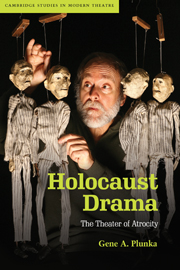Book contents
- Frontmatter
- Contents
- Acknowledgments
- 1 Introduction
- 2 Staging the Banality of Evil
- 3 Culture and the Holocaust
- 4 The Holocaust as Literature of the Body
- 5 Transcending the Holocaust
- 6 Marxism and the Holocaust
- 7 Aryan Responsibility During the Holocaust, I
- 8 Aryan Responsibility During the Holocaust, II
- 9 Heroism and Moral Responsibility in the Ghettoes
- 10 Dignity in the Concentration Camps
- 11 Holocaust Survivors in the United States and Israel
- 12 The Survivor Syndrome and the Effects of the Holocaust on Survivor Families
- 13 Holocaust Survivor Memory
- 14 The Holocaust and Collective Memory
- Notes
- Bibliography
- Index
11 - Holocaust Survivors in the United States and Israel
Published online by Cambridge University Press: 01 July 2009
- Frontmatter
- Contents
- Acknowledgments
- 1 Introduction
- 2 Staging the Banality of Evil
- 3 Culture and the Holocaust
- 4 The Holocaust as Literature of the Body
- 5 Transcending the Holocaust
- 6 Marxism and the Holocaust
- 7 Aryan Responsibility During the Holocaust, I
- 8 Aryan Responsibility During the Holocaust, II
- 9 Heroism and Moral Responsibility in the Ghettoes
- 10 Dignity in the Concentration Camps
- 11 Holocaust Survivors in the United States and Israel
- 12 The Survivor Syndrome and the Effects of the Holocaust on Survivor Families
- 13 Holocaust Survivor Memory
- 14 The Holocaust and Collective Memory
- Notes
- Bibliography
- Index
Summary
About half of the Jewish survivors (120,000) interned in Displaced Persons camps in Germany, Austria, and Italy after the liberation emigrated to Palestine, which was to become Israel in May 1948; another 80,000 to 90,000 of those interned went to the United States. After the war, approximately 140,000 survivors fled to the United States while nearly 350,000 embarked for Palestine. A large majority of the remaining Jews, which represented a small portion of the total number of survivors, emigrated to Canada, Australia, South Africa, or Argentina. Most survivors suffered from depression and anxiety, as well as various psychological and psychosomatic disorders resulting from the traumas associated with the Holocaust–a subject that will be examined in chapter 12. This chapter will focus on the plays that probe the difficulties that survivors had in adjusting to their new lives in the United States (Barbara Lebow's A Shayna Maidel) and the problems that Sabra Jews (native-born Israelis) had in accepting Old World Diaspora Jews into Israeli culture (Leah Goldberg's Lady of the Castle and Ben-Zion Tomer's Children of the Shadows).
Survivors who emigrated to the United States, many of them suffering from severe psychological trauma, had to accommodate to a much more complex lifestyle, learn a foreign language, adapt to new laws and customs, and build a new support structure. English, in particular, exacerbated problems for survivors.
- Type
- Chapter
- Information
- Holocaust DramaThe Theater of Atrocity, pp. 252 - 274Publisher: Cambridge University PressPrint publication year: 2009

